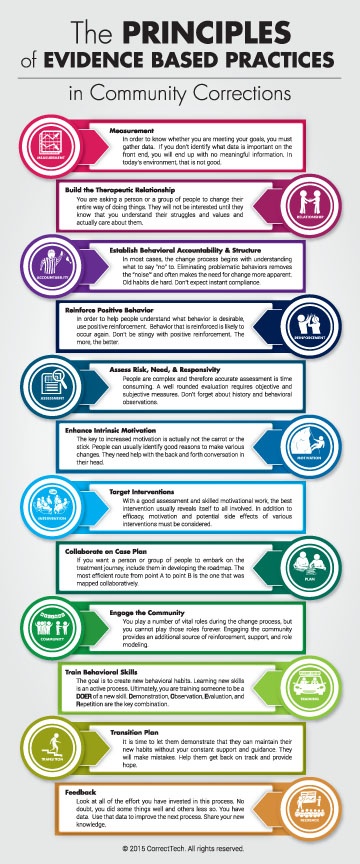- Home
- Software
- Support and Services
- Programs We Serve
- EBP
- Testimonials
- Blog
- About Us
- Resources
If you want a party to embark on the treatment journey, include them in developing the roadmap. The most efficient route from point A to point B is the one that was determined collaboratively.
Yes, the Plan principle brings the other principles into action for your client! Build on other principles to create a collaborative treatment plan such as relationships, motivation and community. When the treatment process begins by looking at the future rather than the past and investigating values rather than failures, the sense of partnership and collaboration is ignited out of the gate building a therapeutic relationship. Also, remember the idea that intrinsic motivation is “pulled” from a person rather than “pushed” upon them.
By exposing the client’s personal values rather than imposing ours, change talk begins. Also, tapping into motivation FOR something rather than AGAINST something is more energizing. Continue the process by engaging ongoing support in natural communities. If you listen closely, you will hear the client identifying what community relationships/resources he or she wants to improve. Personal values will almost always include some type of community relationship (e.g., be a better father, start my own business, help others). Even when a stated personal value is not explicitly related to the community, there is the implication of the need for some type of community support (e.g., sobriety, religion, stability).
The key to creating a value-based treatment plan is to help the client understand that values are not simply a cognitive construct but rather actions and behaviors. True values always manifest in behavior. Thinking and talking about being a better father does not really make it a value. Taking action to spend more time with your child, including remaining in the community to ensure that as an option, is reflective of a true value.
Offenders have felt like a failure for a long time and often do not believe that they can change. Make the first action steps, or first level in your case plan progression, so easy that they cannot fail. Success breeds success. Every goal in a treatment plan should be connected to both a value and a criminogenic need. And every step in the treatment plan needs to be translated to action and ultimately measured by regular progress steps, documented as part of every client’s own story of success. We actually can refer to them as “action plans” for that reason.
Once personal values are defined, identifying what is currently “getting in the way” of living those values (aka criminogenic factors) is a natural next step.
It is not magic, but if you typically start with problems and experience lots of resistance, it may feel that way. This can be the most difficult part of putting EBP into action in a consistent and sustainable way.
With the guidance of both our own customers’ experience and the state of Colorado’s and other statesstandards for building progressive action plans, we've developed a set of integrated software tools to help you make a collaborative and customized case plan for every client. Click on our software icons below to see how we've implemented the plan principle in our software.

CorrectTech offers integrated software and support services for residential, treatment, reentry, juvenile and probation programs. Our community corrections software was designed by community corrections professionals to guide organizations toward a powerful EBP implementation, relieve them of strenuous paperwork and manual processes, and enable them to focus on what matters - people! To request more information or schedule a demonstration of our software, click here.
CorrectTech, Inc.
info@correcttech.com
Copyright 2018 CorrectTech, Inc. All Rights Reserved.